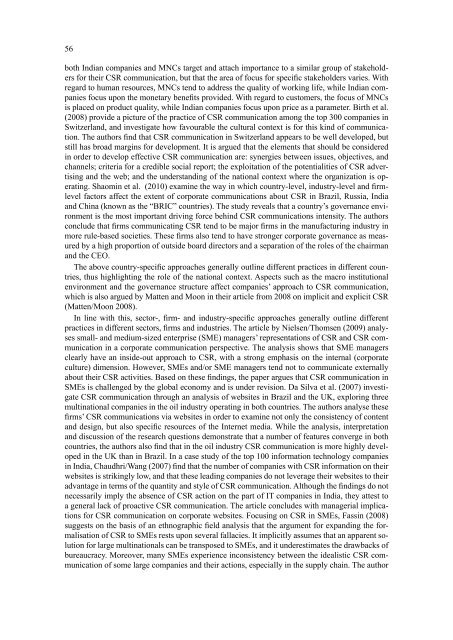Download - Hermes - Journal of Linguistics
Download - Hermes - Journal of Linguistics
Download - Hermes - Journal of Linguistics
You also want an ePaper? Increase the reach of your titles
YUMPU automatically turns print PDFs into web optimized ePapers that Google loves.
56<br />
both Indian companies and MNCs target and attach importance to a similar group <strong>of</strong> stakeholders<br />
for their CSR communication, but that the area <strong>of</strong> focus for specific stakeholders varies. With<br />
regard to human resources, MNCs tend to address the quality <strong>of</strong> working life, while Indian companies<br />
focus upon the monetary benefits provided. With regard to customers, the focus <strong>of</strong> MNCs<br />
is placed on product quality, while Indian companies focus upon price as a parameter. Birth et al.<br />
(2008) provide a picture <strong>of</strong> the practice <strong>of</strong> CSR communication among the top 300 companies in<br />
Switzerland, and investigate how favourable the cultural context is for this kind <strong>of</strong> communication.<br />
The authors find that CSR communication in Switzerland appears to be well developed, but<br />
still has broad margins for development. It is argued that the elements that should be considered<br />
in order to develop effective CSR communication are: synergies between issues, objectives, and<br />
channels; criteria for a credible social report; the exploitation <strong>of</strong> the potentialities <strong>of</strong> CSR advertising<br />
and the web; and the understanding <strong>of</strong> the national context where the organization is operating.<br />
Shaomin et al. (2010) examine the way in which country-level, industry-level and firmlevel<br />
factors affect the extent <strong>of</strong> corporate communications about CSR in Brazil, Russia, India<br />
and China (known as the “BRIC” countries). The study reveals that a country’s governance environment<br />
is the most important driving force behind CSR communications intensity. The authors<br />
conclude that firms communicating CSR tend to be major firms in the manufacturing industry in<br />
more rule-based societies. These firms also tend to have stronger corporate governance as measured<br />
by a high proportion <strong>of</strong> outside board directors and a separation <strong>of</strong> the roles <strong>of</strong> the chairman<br />
and the CEO.<br />
The above country-specific approaches generally outline different practices in different countries,<br />
thus highlighting the role <strong>of</strong> the national context. Aspects such as the macro institutional<br />
environment and the governance structure affect companies’ approach to CSR communication,<br />
which is also argued by Matten and Moon in their article from 2008 on implicit and explicit CSR<br />
(Matten/Moon 2008).<br />
In line with this, sector-, firm- and industry-specific approaches generally outline different<br />
practices in different sectors, firms and industries. The article by Nielsen/Thomsen (2009) analyses<br />
small- and medium-sized enterprise (SME) managers’ representations <strong>of</strong> CSR and CSR communication<br />
in a corporate communication perspective. The analysis shows that SME managers<br />
clearly have an inside-out approach to CSR, with a strong emphasis on the internal (corporate<br />
culture) dimension. However, SMEs and/or SME managers tend not to communicate externally<br />
about their CSR activities. Based on these findings, the paper argues that CSR communication in<br />
SMEs is challenged by the global economy and is under revision. Da Silva et al. (2007) investigate<br />
CSR communication through an analysis <strong>of</strong> websites in Brazil and the UK, exploring three<br />
multinational companies in the oil industry operating in both countries. The authors analyse these<br />
firms’ CSR communications via websites in order to examine not only the consistency <strong>of</strong> content<br />
and design, but also specific resources <strong>of</strong> the Internet media. While the analysis, interpretation<br />
and discussion <strong>of</strong> the research questions demonstrate that a number <strong>of</strong> features converge in both<br />
countries, the authors also find that in the oil industry CSR communication is more highly developed<br />
in the UK than in Brazil. In a case study <strong>of</strong> the top 100 information technology companies<br />
in India, Chaudhri/Wang (2007) find that the number <strong>of</strong> companies with CSR information on their<br />
websites is strikingly low, and that these leading companies do not leverage their websites to their<br />
advantage in terms <strong>of</strong> the quantity and style <strong>of</strong> CSR communication. Although the findings do not<br />
necessarily imply the absence <strong>of</strong> CSR action on the part <strong>of</strong> IT companies in India, they attest to<br />
a general lack <strong>of</strong> proactive CSR communication. The article concludes with managerial implications<br />
for CSR communication on corporate websites. Focusing on CSR in SMEs, Fassin (2008)<br />
suggests on the basis <strong>of</strong> an ethnographic field analysis that the argument for expanding the formalisation<br />
<strong>of</strong> CSR to SMEs rests upon several fallacies. It implicitly assumes that an apparent solution<br />
for large multinationals can be transposed to SMEs, and it underestimates the drawbacks <strong>of</strong><br />
bureaucracy. Moreover, many SMEs experience inconsistency between the idealistic CSR communication<br />
<strong>of</strong> some large companies and their actions, especially in the supply chain. The author
















